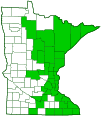Bohemian knotweed
(Reynoutria × bohemica)
Conservation • Weed • Wetland • Description • Habitat • Ecology • Use • Distribution • Taxonomy
Description |
||
Bohemian knotweed is an erect, 5′ to 8′ tall, perennial forb. It rises on usually clustered stems from a long, creeping, horizontal, underground stem (rhizome). It is a fertile hybrid between two highly invasive plants, Japanese knotweed (Reynoutria japonica) and giant knotweed (Fallopia sachalinensis), and it shares features of both of those plants. The hybrid was introduced into North American and cultivated as an ornamental. It escaped from cultivation and is now naturalized across northern United States. It is reported to be partially or fully fertile, but it spreads mostly by rhizomes and by the dispersal of plant fragments. It is found on river banks, along roadways, and in other disturbed areas. It often forms large dense colonies. The bamboo-like stems are erect, stiff, hollow, green, and hairless. There are usually many slender branches. They are not climbing or twining. They are swollen at the nodes and are covered with a whitish waxy bloom (glaucous). Like other knotweeds (Fallopia and Persicaria), there is a sheath (ocrea) that wraps around the stem at each node. The ocrea is papery, membranous, white to tan or greenish-brown, and usually ⅛″ to ¼″ long, sometimes up to ⅜″ long. It may be hairless or covered with short, fine hairs, but does not have longer bent hairs and does not have bristles at the base. It is usually deciduous. The leaves are alternate, 2″ to 12″ long, and ¾″ to 4″ wide, larger than Japanese knotweed but smaller than giant knotweed. They are on ⅜″ to 1¼″ long leaf stalks. The leaf blade is variable in shape, and may resemble the leaves of either parent. It may be spade-shaped, straight across (truncate) at the base, or slightly heart-shaped, indented (cordate) at the base. Both leaf shapes may appear on the same branch. They are tapered at the tip with concave sides along the tip (acuminate). They do not terminate in a sharp firm point. The upper surface is hairless. The lower surface is glaucous and has minute hairs along the veins. The margins are untoothed and may be hairless of have a short fringe of hairs. Flowers appear from July to October. The inflorescence is an erect or spreading, 1½″ to 4¾″ long, cluster of flowers at the end of each branch and rising from leaf axils. It may be long, narrow, and unbranched (raceme), or short, broad, branched (panicle), and plume-like, and it may be either shorter or longer than the subtending leaf. The flowers are grouped into elongated bundles (fascicles) of 3 to 15 flowers each. There is an ocrea at the base of each fascicle. The flowers are Each flower is ⅛″ to ¼″ (4 to 6 mm) long and is constricted and stipe-like at the base. There are 5 petal-like tepals, 8 stamens, and 3 styles. The tepals are egg-shaped to ellipse-shaped, creamy white or greenish-white, and hairless. The outer 3 tepals are long and winged along the midrib, the inner two shorter and unwinged. All of the tepals become larger as the fruit forms. The styles are fused at the base. Each flower appears perfect, with both male and female reproductive parts, but some of the flowers are female, with nonfunctional male parts. The fruit is a single-chambered seed capsule (achene). The achene is 1 ⁄16″ to ⅛″ (2.6 to 3.2 mm) long, dark brown, shiny, and smooth. |
||
Height |
||
5′ to 8′ |
||
Flower Color |
||
Greenish-white to pink |
||
Similar Species |
||
Habitat |
||
Rivers; roadways and other disturbed areas |
||
Ecology |
||
Flowering |
||
July to October |
||
Pests and Diseases |
||
|
||
Use |
||
|
||
Distribution |
||||
|
Sources |
|||
| 2/26/2023 | ||||
Nativity |
||||
Both parent plants are native to Asia. The hybrid was introduced and cultivated as an ornamental. It escaped cultivation and is now naturalized in North America. |
||||
Occurrence |
||||
Uncommon |
||||
Taxonomy |
|||
| Kingdom | Plantae (Plants) | ||
| Division | Tracheophyta (Vascular Plants) | ||
| Subdivision | Spermatophytina (Seed Plants) | ||
| Class | Magnoliopsida (Dicots) | ||
| Superorder | Caryophyllanae | ||
Order |
Caryophyllales (Pinks, Cactuses, and Allies) | ||
Family |
Polygonaceae (knotweed) | ||
| Subfamily | Polygonoideae | ||
| Tribe | Polygoneae | ||
| Subtribe | Reynoutriinae | ||
Genus |
Reynoutria | ||
Hybrid Genus Species Complex |
|||
Subordinate Taxa |
|||
|
|||
Synonyms |
|||
Fallopia × bohemica Polygonum × bohemicum |
|||
Common Names |
|||
Bohemian knotweed |
|||
Glossary
Achene
A dry, one-chambered, single-seeded seed capsule, formed from a single carpel, with the seed attached to the membranous outer layer (wall) only by the seed stalk; the wall, formed entirely from the wall of the superior ovary, does not split open at maturity, but relies on decay or predation to release the contents.
Acuminate
Gradually tapering with concave sides to a sharply pointed tip.
Axil
The upper angle where a branch, stem, leaf stalk, or vein diverges.
Fascicle
A small bundle or cluster, often sheathed at the base, as with pine needles.
Glaucous
Pale green or bluish gray due to a whitish, powdery or waxy film, as on a plum or a grape.
Node
The small swelling of the stem from which one or more leaves, branches, or buds originate.
Ocrea
A sheath around the stem at the base of a petiole formed from the stipules; a feature of many members of the Polygonaceae.
Panicle
A pyramidal inflorescence with a main stem and branches. Flowers on the lower, longer branches mature earlier than those on the shorter, upper ones.
Perfect
Referring to a flower that has both male and female reproductive organs.
Petiole
On plants: The stalk of a leaf blade or a compound leaf that attaches it to the stem. On ants and wasps: The constricted first one or two segments of the rear part of the body.
Raceme
An unbranched, elongated inflorescence with stalked flowers. The flowers mature from the bottom up.
Rhizome
A horizontal, usually underground stem. It serves as a reproductive structure, producing roots below and shoots above at the nodes.
Twining
Growing in a spiral usually around a stem of another plant that serves as support.
Visitor Photos |
|||||
Share your photo of this plant. |
|||||
| This button not working for you? Simply email us at info@MinnesotaSeasons.com. Attach one or more photos and, if you like, a caption. |
|||||
|
|||||
MinnesotaSeasons.com Photos |
|||||
Branch |
|||||
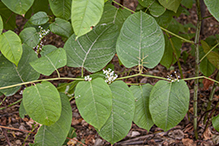 |
|||||
Plume-like Inflorescence |
|||||
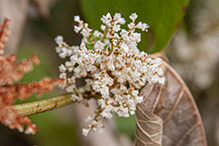 |
|||||
| Spade-shaped Leaf | |||||
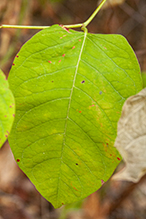 |
|||||
Shallowly Heart-shaped Leaf |
|||||
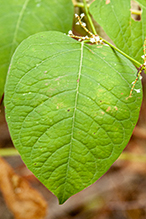 |
|||||

Visitor Videos |
|||
Share your video of this plant. |
|||
| This button not working for you? Simply email us at info@MinnesotaSeasons.com. Attach a video, a YouTube link, or a cloud storage link. |
|||
Other Videos |
|||
| Emerging Bohemian Knotweed ISCMV |
|||
About
Apr 21, 2020 Ever wondered what Bohemian knotweed looks like as it starts to emerge in the spring? Check out this video by the Invasive Species Council of Metro Vancouver (ISCMV) to see new growth of knotweed, emerging alongside last years dead knotweed canes. |
|||
| Identification of Invasive Perennial Knotweeds Wisconsin First Detector Network |
|||
About
Jun 11, 2018 Learn how to identify three invasive perennial knotweeds in Wisconsin from the Wisconsin First Detector Network. |
|||

Visitor Sightings |
|||||
Report a sighting of this plant. |
|||||
| This button not working for you? Simply email us at info@MinnesotaSeasons.com. Be sure to include a location. |
|||||
|
|||||
MinnesotaSeasons.com Sightings |
|||||

|
Created: Last Updated: © MinnesotaSeasons.com. All rights reserved. |
